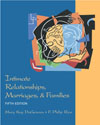Sex designates the biological identity of being male or female; gender includes
the psychosocial characteristics that characterize us as masculine or feminine.
Gender identity and gender roles are acquired through environmental influences.
Three major influences on children's learning of gender identity and roles are
parents, television, and schools. There are also many varied theories suggesting
the establishment of gender roles. These range from adapting to societal influences
such as media and peers, the pressures of intellectual development, as well
as biological evolution. Stereotyped concepts pertaining to masculinity and
femininity also can be learned, and these can limit personality development
and personal achievement, interpersonal relationships, and family roles. Females
today commonly develop much of their self identity from the media's portrayal
of an often unattainable ideal, leading to health problems and poor self-image.
Egalitarian roles (shared responsibility for housework and child care) appear
to have a positive influence on marital satisfaction, individual psychological
well-being, and quality of child care and can be an important consideration
in mate selection. There appears to be some evidence that family roles become
more egalitarian over the course of the family life cycle. The present trend
toward androgyny, or mixing of roles, appears to be advantageous to both sexes
whose gender roles may be changed based on their social context. |



 2002 McGraw-Hill Higher Education
2002 McGraw-Hill Higher Education